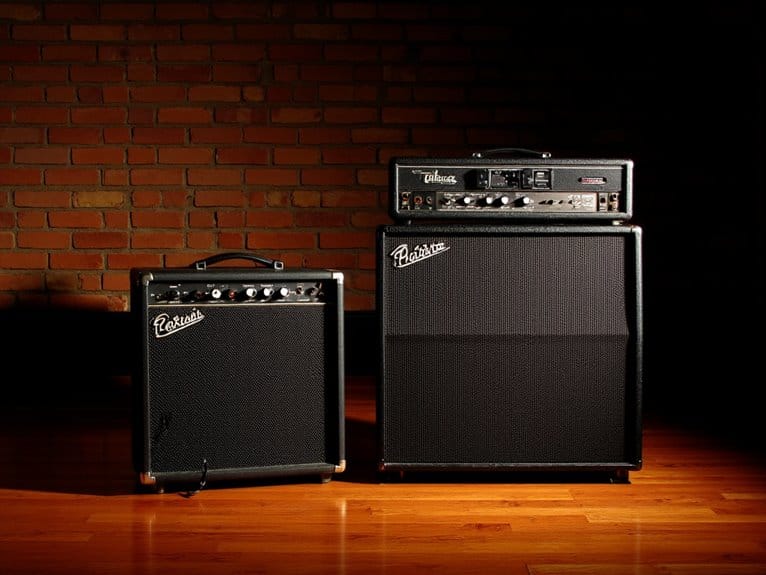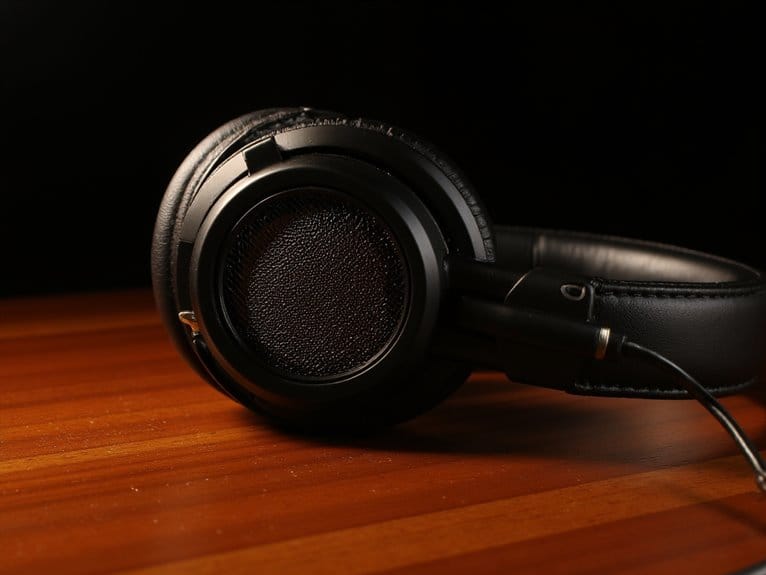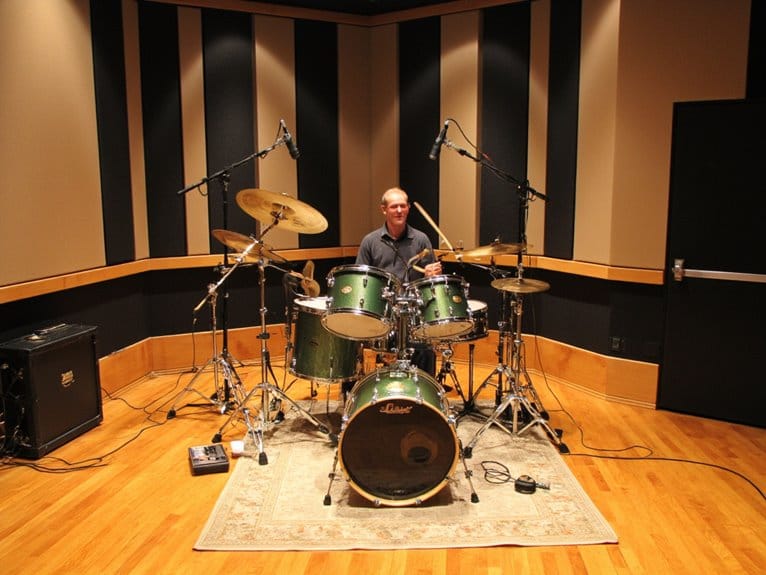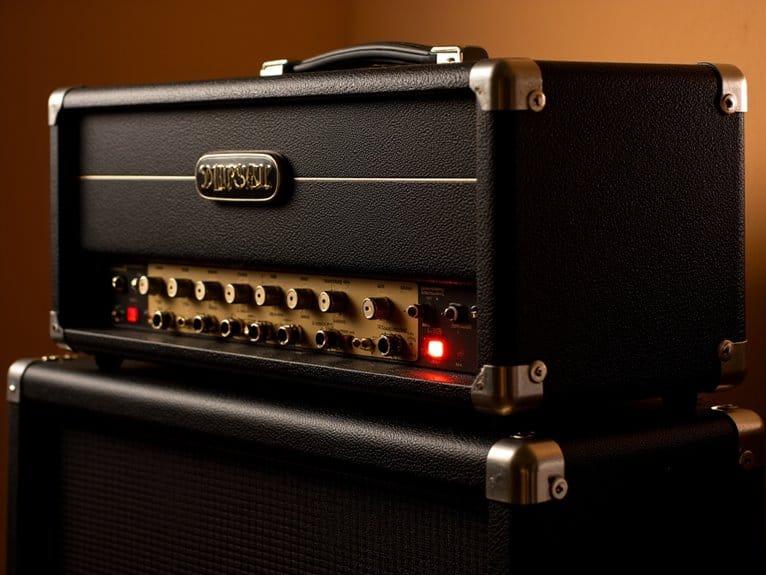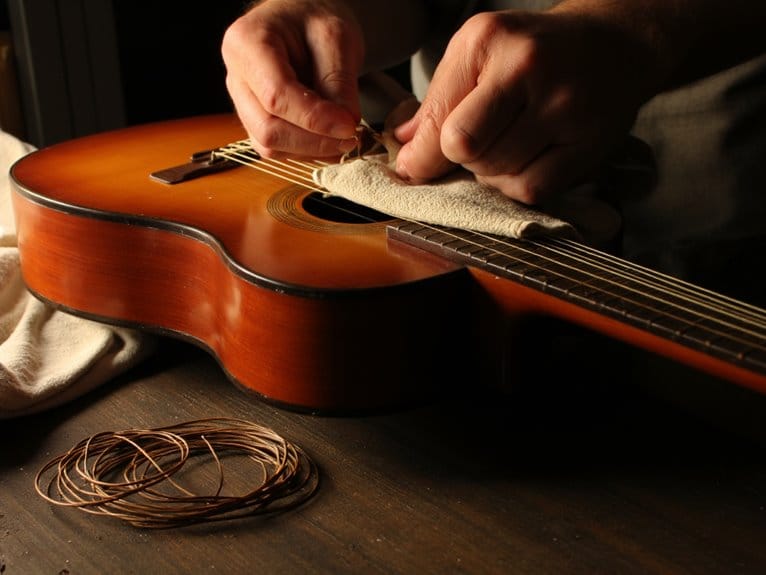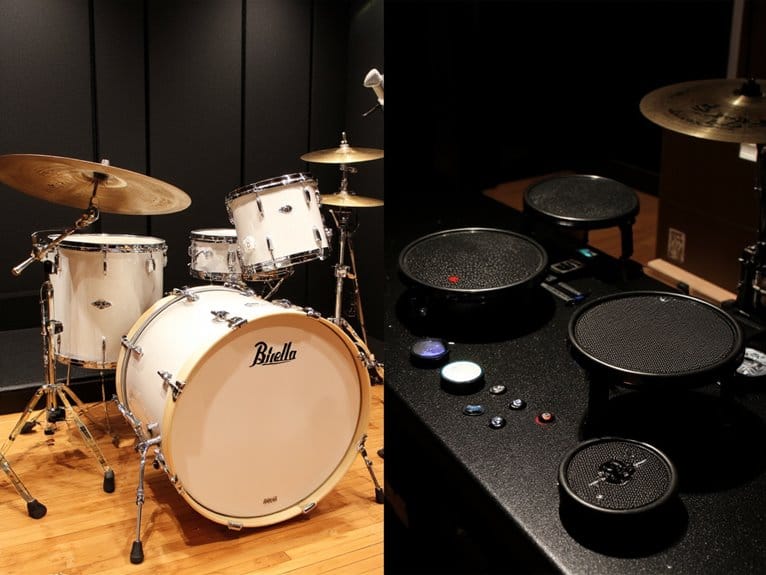Practice Guitar Amps Vs Performance Amps: Finding the Sweet Spot
You’ll find the sweet spot between practice and performance amps by matching wattage to your environment—1-20 watts for home practice, 20-45 watts for rehearsals and small gigs. Practice amps under $300 offer essential features like headphone outputs and basic effects, while performance models starting at $500 provide XLR outputs and multiple channels. Consider that tube amps feel louder than solid-state equivalents, and 12-inch speakers deliver better harmonic complexity than smaller drivers. Understanding these distinctions will help you make the right investment for your specific musical journey.
We are supported by our audience. When you purchase through links on our site, we may earn an affiliate commission, at no extra cost for you. Learn more.
Notable Insights
- Practice amps (1-20W) excel for home use with headphone outputs, while performance amps (20-45W+) provide stage volume.
- Under-$200 practice amps offer excellent value, whereas performance models starting at $300+ deliver professional features.
- 10-15W tube amps provide the sweet spot, offering power-amp distortion without overwhelming small spaces.
- Practice amps feature 1-2 channels with basic effects; performance amps include multiple channels and XLR outputs.
- Consider dual-purpose: 20W amps with headphone jacks bridge practice and small gig requirements effectively.
Power and Volume: Understanding Wattage Requirements for Different Settings
Why does choosing the right wattage for your guitar amp feel like solving a puzzle where the pieces keep changing shape? Your amp selection hinges on understanding that wattage doesn’t scale linearly with volume—doubling watts only gives you a 3 dB increase, which you’ll notice but won’t double your perceived loudness.
Amp wattage is a shape-shifting puzzle—doubling watts only adds 3 dB, not double the perceived volume.
For home practice, I’ve found that 1-20 watts provides manageable volume control while still delivering that coveted power-amp distortion at reasonable levels. Amplifiers of 10W to 15W are particularly well-suited for practice sessions since they maintain clarity without overwhelming distortion in smaller spaces.
When you’re rehearsing or playing small gigs, you’ll need 20-45 watts to compete with drums effectively. A 20W tube amp generally feels louder than a 20W solid-state amp due to the natural harmonic distortion and compression that tube designs provide. Additionally, speaker efficiency measured in decibels significantly impacts your actual output levels, meaning lower-efficiency speakers will produce quieter sound even when paired with identical amplifiers.
The sweet spot often lies in understanding that higher wattage gives you cleaner headroom, while lower wattage cranked up creates natural overdrive—both valuable depending on your musical goals. To achieve professional recording quality, many guitarists pair their amplifiers with audio interfaces that offer high-resolution converters and ultra-low-noise preamps for optimal signal capture.
Size and Portability: Balancing Sound Quality With Practical Transportation Needs
Once you’ve nailed down your wattage requirements, the reality of hauling your amp around starts to sink in—and I’ve learned the hard way that even the best-sounding amp becomes a burden if you can’t easily transport it to where you need to play.
The size-versus-sound trade-off becomes crystal clear when you’re comparing options.
Ultra portable options like mini amps sacrifice some tonal depth for convenience, but modern engineering has narrowed this gap considerably.
Here’s what you’ll encounter across different size categories:
- Desktop mini amps can be as small as 3 inches tall, weighing under 1 kg, perfect for backpack transport
- Practice combos with 8-10″ speakers balance portability with decent bass response, typically under 6 kg
- Performance rigs with 12-15″ speakers deliver full tonal range but require vehicle transport and proper cases
The lightest models start at just 4.9 ounces, with battery-powered designs facilitating outdoor jam sessions and street performances without requiring wall outlets.
For apartment dwellers, models like the Fender Frontman 10G offer a sweet spot at 11.7 pounds, providing enhanced bass response through a 6-inch speaker while remaining easily manageable for transport.
Essential Features: Built-in Effects, Channels, and Connectivity Options
Three core features can make or break your amp experience—built-in effects, channel configuration, and connectivity options—and I’ve found that understanding these elements before you buy saves countless headaches down the road. Additionally, it’s essential to consider how these features can enhance your overall sound and performance. For instance, the guitar combo amps advantages include their portability and all-in-one design, making them ideal for practice sessions and small gigs. By carefully evaluating these aspects, you can ensure that your amp meets your musical needs and preferences.
Practice amps typically offer basic built-in effects like reverb and delay, while performance amps pack extensive multi-effects processors with dozens of presets.
Channel switching becomes essential here, as practice amps usually provide one to two channels for simple clean-to-overdrive changes, whereas performance amps deliver multiple independent channels with dedicated EQ settings. Quality dual-channel design allows seamless switching between clean and overdriven tones for live performance.
Connectivity wise, you’ll get headphone outputs and auxiliary inputs on practice amps, but performance amps prioritize XLR outputs, effects loops, and MIDI connectivity for professional integration.
For beginners, Bluetooth connectivity on modern practice amps allows streaming of backing tracks directly from smartphones or tablets, making practice sessions more engaging and interactive.
Tone Quality: Speaker Size, Tube Technology, and Sound Projection Differences
When it comes to tone quality, the relationship between speaker size, tube technology, and sound projection creates the foundation of your amp’s sonic character. I’ve learned that these three elements work together in ways that can profoundly reshape your guitar’s voice.
Speaker characteristics directly influence your amp’s frequency response, with 10-inch drivers delivering punchy midrange focus while 12-inch speakers offer balanced harmonic complexity. Tube types like EL34s provide pronounced mid-range warmth, whereas 6L6 tubes deliver cleaner headroom with brighter highs.
Speaker size and tube selection fundamentally shape your amp’s tonal DNA, determining whether you achieve focused punch or expansive harmonic richness.
Key factors affecting your tone include:
- Sound dispersion varies greatly between 1×12 cabinets (focused projection) and 2×12 configurations (wider spread)
- Harmonic complexity increases with larger speakers that move more air
- Frequency response changes vastly based on cone size and cabinet design
Understanding these interactions helps you choose amps that complement your playing style and venue requirements. For optimal clean performance, look for amplifiers with a frequency response of 100Hz to 20kHz, which ensures crystal-clear sound reproduction across the entire audible spectrum. For bass instruments specifically, higher wattage amplifiers consistently produce cleaner, more defined tones that maintain clarity even in demanding live environments.
Budget and Investment: Cost Considerations for Your Musical Journey
While tone quality might capture your heart, budget considerations will ultimately determine which amp makes it home with you. I’ve discovered that understanding the financial landscape of guitar amplifiers can save you from both overspending on features you don’t need and underinvesting in capabilities that matter.
Effective cost analysis reveals that practice amps typically range from $50 to $500, while performance models stretch from $500 to $7,000, particularly for tube technology. Your investment prioritization should align with your primary use case, as beginners benefit from affordable practice amps under $300.
Intermediate players often invest in mid-range options between $300-$1,500, and professionals allocate budgets exceeding $1,000 for reliable performance equipment that meets demanding live-show requirements. Entry-level models starting around $50 can deliver solid performance while premium options exceeding $300 may surpass typical practice needs for most players. The under-$200 market offers excellent options like the Fender Mustang LT25 and Leo Jaymz 20W that provide good performance-to-price ratios without sacrificing essential features for developing musicians.
Frequently Asked Questions
Do Practice Amps Work Well for Recording in Professional Studios?
You’ll find practice amps surprisingly effective for studio quality recordings when properly miked and processed. Their unique character excels at tone shaping, especially for layering textures or achieving distinctive sounds that larger amps can’t replicate.
Can I Connect Multiple Guitars to One Amp for Jamming Sessions?
You can connect multiple guitars to one amp using combiner pedals or ABY boxes for jamming gear. These guitar amp setups prevent signal loss and volume drops while letting you switch between instruments or play simultaneously.
On a final note
You don’t need to break the bank or sacrifice portability for great tone. Whether you’re jamming in your bedroom or performing on stage, the right amp balances your specific needs with practical considerations. Consider your primary use case, budget constraints, and growth potential when making your decision. Remember, you can always upgrade later as your skills and requirements evolve throughout your musical journey.

